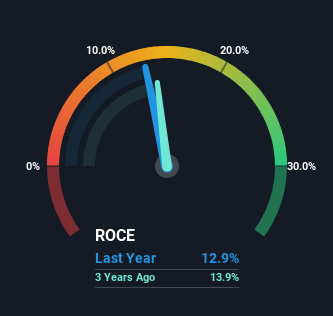Treatt (LON:TET) Hasn't Managed To Accelerate Its Returns
If you're looking for a multi-bagger, there's a few things to keep an eye out for. Firstly, we'd want to identify a growing return on capital employed (ROCE) and then alongside that, an ever-increasing base of capital employed. Ultimately, this demonstrates that it's a business that is reinvesting profits at increasing rates of return. So, when we ran our eye over Treatt's (LON:TET) trend of ROCE, we liked what we saw.
Return On Capital Employed (ROCE): What Is It?
If you haven't worked with ROCE before, it measures the 'return' (pre-tax profit) a company generates from capital employed in its business. The formula for this calculation on Treatt is:
Return on Capital Employed = Earnings Before Interest and Tax (EBIT) ÷ (Total Assets - Current Liabilities)
0.13 = UK£18m ÷ (UK£175m - UK£33m) (Based on the trailing twelve months to September 2023).
So, Treatt has an ROCE of 13%. By itself that's a normal return on capital and it's in line with the industry's average returns of 13%.
See our latest analysis for Treatt
In the above chart we have measured Treatt's prior ROCE against its prior performance, but the future is arguably more important. If you're interested, you can view the analysts predictions in our free analyst report for Treatt .
What The Trend Of ROCE Can Tell Us
The trend of ROCE doesn't stand out much, but returns on a whole are decent. Over the past five years, ROCE has remained relatively flat at around 13% and the business has deployed 61% more capital into its operations. 13% is a pretty standard return, and it provides some comfort knowing that Treatt has consistently earned this amount. Over long periods of time, returns like these might not be too exciting, but with consistency they can pay off in terms of share price returns.
On a side note, Treatt has done well to reduce current liabilities to 19% of total assets over the last five years. Effectively suppliers now fund less of the business, which can lower some elements of risk.
The Key Takeaway
The main thing to remember is that Treatt has proven its ability to continually reinvest at respectable rates of return. And given the stock has only risen 2.9% over the last five years, we'd suspect the market is beginning to recognize these trends. That's why it could be worth your time looking into this stock further to discover if it has more traits of a multi-bagger.
If you'd like to know about the risks facing Treatt, we've discovered 1 warning sign that you should be aware of.
If you want to search for solid companies with great earnings, check out this free list of companies with good balance sheets and impressive returns on equity.
Have feedback on this article? Concerned about the content? Get in touch with us directly. Alternatively, email editorial-team (at) simplywallst.com.
This article by Simply Wall St is general in nature. We provide commentary based on historical data and analyst forecasts only using an unbiased methodology and our articles are not intended to be financial advice. It does not constitute a recommendation to buy or sell any stock, and does not take account of your objectives, or your financial situation. We aim to bring you long-term focused analysis driven by fundamental data. Note that our analysis may not factor in the latest price-sensitive company announcements or qualitative material. Simply Wall St has no position in any stocks mentioned.

